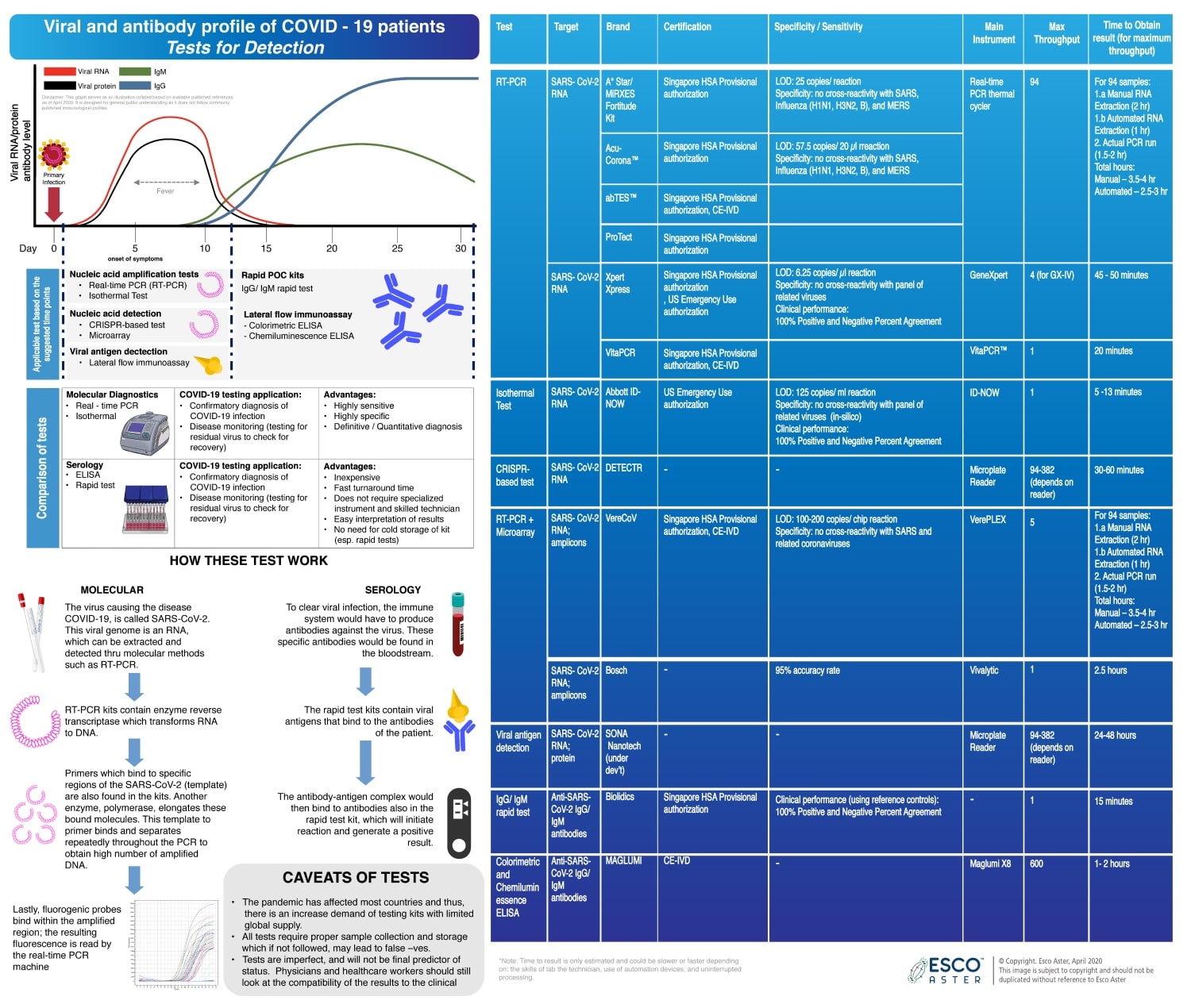
The key message “Test, Test, Test” delivered by the WHO Director-General, Dr. Tedros Ghebreyesus, last Mar. 16 was directed for all countries; testing every suspected case so that they can be immediately isolated and their close contact, traced. Adequate testing should help in breaking the pandemic’s chain of infection and flattening its epidemiological curve.
On Apr. 6, WHO coronavirus team lead Dr. Kerkhove announced at a news conference that it is possible for presymptomatic patients to transmit the disease, similar to symptomatic, through respiratory droplets. This is further justified by the study of the presymptomatic transmission of COVID-19 cases in Singapore. Wei and colleagues have identified 10 of 157 cases from Jan. 23 to Mar. 16 are attributed to presymptomatic transmission. These findings should be taken into consideration in contact tracing as well as testing for asymptomatic cases.

Figure 1. Viral and antibody profiles and the corresponding tests
Viral and antibody profiles from COVID-19 patients do follow findings from Wei et. al.; viral shedding occurs even before the onset of symptoms (in some cases even in the absence of symptoms). Once infected, it would take some time for symptoms such as fever and cough to develop, hence, yet virus already multiplies in the body. By the time the person has a fever, viral concentration is already at peak. For accurate presymptomatic testing, molecular diagnostic tests are applicable as seen in Fig. 1. Viral antigen detection is also plausible but commercial tests have not yet been validated to conform to the gold standard, reverse-transcription polymerase chain reaction (RT-PCR).
Serological tests, although more rapid and cost-effective against molecular tests, are not recommended for early diagnosis. The sensitivity of IgM tests is only 70% for 4 to 10 days after the onset of symptoms and rapidly rise thereafter. It is then advisable to use these tests for monitoring those in quarantine, stay-at-home notice, and/or on lockdown for better contact tracing.
The different commercial diagnostic tests, as well as kits that are being developed, outlined in Fig. 1. As more countries are being affected by the COVID-19 pandemic, more kits should be manufactured and updated. Each diagnostic test platforms do have caveats and results should be interpreted by clinicians and scientists in correlation with other pertinent laboratory tests and clinical history.
Esco Aster end-to-end platforms include technologies that enable testing of COVID-19: from molecular diagnostics to serological assay. Learn more about Esco Aster Trace, Test, and Treat Platform.
Read on the developments of COVID-19 and what Esco can provide:
-
Vaccine Development
-
One Health Approach for Diagnostic/Vaccine Self-Sufficiency
References:
-
Higgins-Dunn, N. & Miller (2020). WHO says the coronavirus can spread one to three days before symptoms start. CNBC LLC. Retrieved April 7, 2020 from https://www.cnbc.com/2020/04/06/who-says-the-coronavirus-can-spread-one-to-three-days-before-symptoms-start.html
-
Sheridan, C. (2020). Fast, portable tests come online to curb coronavirus pandemic. Nature Biotechnology. doi: 10.1038/d41587-020-00010-2
-
Wei WE, Li Z, Chiew CJ, Yong SE, Toh MP, Lee VJ. Presymptomatic Transmission of SARS-CoV-2 — Singapore, January 23–March 16, 2020. MMWR Morb Mortal Wkly Rep. ePub: 1 April 2020. DOI: http://dx.doi.org/10.15585/mmwr.mm6914e1external icon